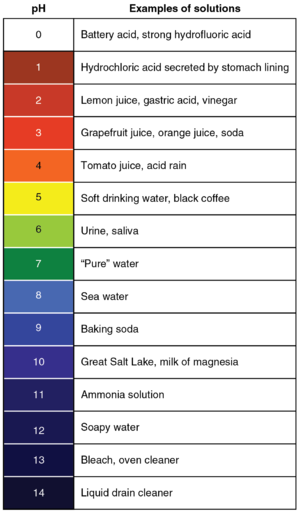Difference between revisions of "PH"
(→Higher=) |
|||
| Line 18: | Line 18: | ||
: The '''pH''' of a [[solution]] is determined by the strength and [[concentration]] of [[Hydrogen Ion|Hydrogen ions]] in an [[acid]] or [[Hydroxide Ion|Hydroxide ions]] in an [[alkali]]. | : The '''pH''' of a [[solution]] is determined by the strength and [[concentration]] of [[Hydrogen Ion|Hydrogen ions]] in an [[acid]] or [[Hydroxide Ion|Hydroxide ions]] in an [[alkali]]. | ||
| − | ====Higher | + | ====Higher==== |
: In [[acid]]s for a '''pH''' decrease of 1 there must be 10 times greater [[concentration]] of [[Hydrogen Ion|Hydrogen ions]] in [[solution]]. | : In [[acid]]s for a '''pH''' decrease of 1 there must be 10 times greater [[concentration]] of [[Hydrogen Ion|Hydrogen ions]] in [[solution]]. | ||
Revision as of 13:08, 4 January 2019
Contents
Key Stage 3
Meaning

A pH scale with the colours of Universal Indicator at those pH values and some examples of substances at those pH values.
The pH scale is a numbered list from 1 to 14 that is used to identify how acidic or basic a substance is.
About pH
- pH is written with a lower case p and an upper case H and refers to the 'power of Hydrogen' as there are free Hydrogen ions in an acid.
- Acids range from 0-6.9 on the pH scale with the strongest acids being at pH 0.
- Bases range from 7.1-14 on the pH scale with the strongest bases being at pH 14. Remember alkalis are a base dissolved in water.
- pH 7.0 is neutral.
Key Stage 4
Meaning
The pH scale is a numbered list from 1 to 14 that is used to identify how acidic or basic a substance is.
About the pH Scale
Foundation
- The pH of a solution is determined by the strength and concentration of Hydrogen ions in an acid or Hydroxide ions in an alkali.
Higher
- In acids for a pH decrease of 1 there must be 10 times greater concentration of Hydrogen ions in solution.